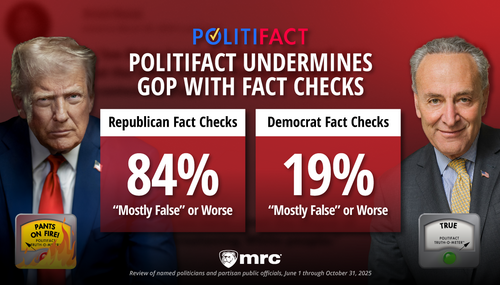One look at statistics – from GDP growth to the unemployment rate – and it’s obvious this isn’t the worst economic time in U.S. history. But it might be the worst journalistically. The major media give us only two degrees of economic news – close to “apocalyptic” and worse. They are so outlandishly negative that coverage of the Bear Stearns buyout was vastly worse than reporting of the 1929 stock market crash.
As the stock market reeled from the Bear Stearns collapse back in March, ABC News asked: Is the “economy heading over a cliff?” Journalists made it seem so, calling the American financial system everything from “bleak” to in a “meltdown.” ABC, CBS and NBC made comparisons to America’s worst economic turmoil – the Great Depression – more than 40 times in the first four months of 2008.
Compare that to how The New York Times summed up its own market outlook in an Oct. 30, 1929, story after billions of dollars were lost in record trading. “Despite the drastic decline, sentiment in Wall Street last night was more cheerful than it has been on any day since the torrent of selling got under way,” wrote the paper. Words like “optimism” and “hope” shouted off the pages of major newspapers. The Oct. 31, 1929, Times described the devastating six-day decline: “the market quickly regained its poise and stability.” The same day, The Washington Post discussed “the passing of the crisis.”
The difference between how the media handled a crisis in 1929 and 2008 was astounding. Network news was four times more negative about the Bear Stearns buyout than major newspapers were about the 1929 crash, which many historians link to the beginning of the Depression. Nearly 80 years later, the crash and the depression that followed are viewed as “the great American trauma,” as economist Murray N. Rothbard wrote in his book “America’s Great Depression.”
The mere mention of the term “depression” evokes images of food lines, Dust Bowl refugees and bank failures. A recent USAToday.com report showed the majority of Americans thought a new “depression” was likely. “Asked if the nation could slip into a depression lasting several years, 59% said it was likely, and 79% said they were worried about it,” explained the story.
No wonder. Reporters like CBS’s Julie Chen warned viewers about the “growing economic meltdown” in a March 17, 2008, story. ABC’s Bianna Golodryga used similar language the very next morning. “Some say the economy is like a house of cards,” she told “Good Morning America” viewers.
Bear Stearns’s collapse, while making some investors justifiably skittish, was nowhere near the market-wide cataclysm of 1929. In six days that ended the roar of the ’20s, Wall Street lost about 30 percent of its value.
Cut to 2008, when the unemployment rate is one-fifth of what it was at the height of the Depression. We’ve yet to see even one quarter of negative GDP growth. Why then was the Bear Stearns coverage worse than news reports from the 1929 crash?
Network news shows have been delivering overly negative reports since 2003. This was standard operating procedure, just more horrific than usual. In 2006, 17 network stories drew comparisons to the Great Depression, from U.S. savings rates to climate change.
It’s no surprise that with 22 million Americans exposed to that just on the evening news, so many fear another depression.
The Business & Media Institute analyzed two much-discussed weeks in America’s stock market history – the crash in 1929 and the week of the Bear Stearns collapse in 2008. BMI compared stories in the 1929 Wall Street Journal, New York Times and Washington Post to daily reports on ABC, CBS and NBC in 2008.
It was easy to find good news amidst the market chaos in 1929. Even in the Times, the most downbeat outlet studied from that era, positive stories still outnumbered negative ones by nearly a 3-to-1 ratio. The Times reported that “there was no denying the increased optimism with which leaders of the financial district viewed the situation.”
The Post took a similarly upbeat view at the end of the week of the crash. On Oct. 30, the Post detailed the strong outlook of the business community in a story headlined: “Bright Future Seen By 98 Business Men.” The next day, the Post declared an end to the crisis as “fear was transformed into confidence.”
The modern news media had no such “confidence” in the markets. ABC found a dark cloud for every silver lining, saying: “And everywhere you look, it’s bad news.” On network news, that statement was accurate.
Dan Gainor is The Boone Pickens Fellow and vice president of the Media Research Center’s Business & Media Institute. He can be seen Friday afternoons each week on Fox Business Network.





